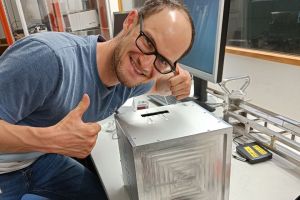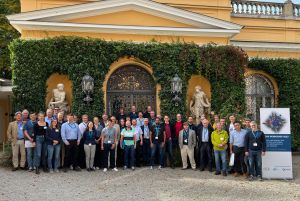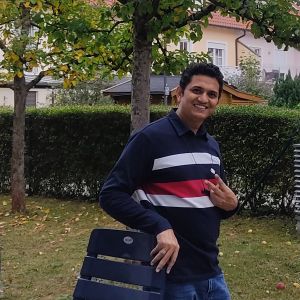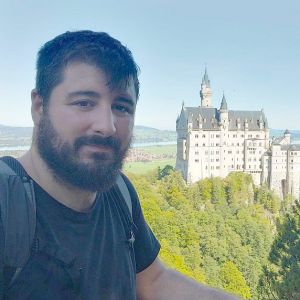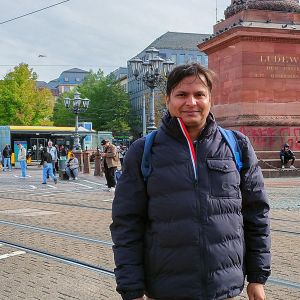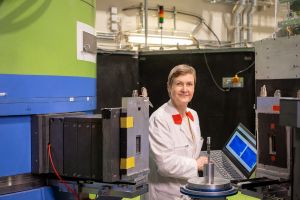MLZ is a cooperation between:
 > Technische Universität München
> Technische Universität München > Helmholtz-Zentrum Hereon
> Helmholtz-Zentrum Hereon
 > Forschungszentrum Jülich
> Forschungszentrum Jülich
MLZ is a member of:
 > LENS
> LENS > ERF-AISBL
> ERF-AISBL
MLZ on social media:

MLZ (eng)
Lichtenbergstr.1
85748 Garching
Newsletter I/2024
Jump directly to the chapters! (and don't forget to enlarge the pictures by clicking them!)
» Welcome!» At the reactor» Instrumentation» Events» People» UsersWelcome!
Ghost writing
Many of you might know me as the software to handle your proposal at the MLZ and to organize beam times. Using artificial intelligence, I recently have overcome the barrier of being jailed in the user office, now floating around and picking up news for my beloved users. As I distribute this News Letter, I found a way to put me on the cover page, replacing the a little bit outdated editorial.
Still impressed by the numerous participants at the user meeting at the end of last year, I am highly motivated to come back to you with a fresh and updated version. Even my pronounced conceitedness says to me that I am properly working, Ina and her co-workers are constantly screwing on my algorithms. I will try to understand what they are doing and report here on any News.
This year has started with a new science director at the FRM II and MLZ. Christian Pfleiderer, formerly known as the chair behind the instrument RESEDA, has taken over the position and was already visible at the user meeting in December. Picking up some corridor conversation, a fresh and substantial wind of change seems to path along the institute. On the other hand, it’s not only me that is missing our users. The entire staff struggles to bring the machine back into operation, even though it will take until the end of this year before our bright neutron beams can shed light on your fascinating research questions.
I already mentioned my conceitedness, which was raised even more during the DPG spring meeting in Berlin. So many young researchers were interested in me and took my business card from the MLZ booth. Let’s keep in contact!
The Ghost
At the reactor
We want to update you on the ongoing work at the FRM II. As you all know, significant challenges must be overcome before returning to routine operations. Our major projects are the replacement of the central channel and the fabrication of a new cold source.
Substantial progress could already be achieved in the manufacturing of the components of the central channel. However, the ambitious timeline to come back into user operation this year has become very unlikely. The central channel’s installation is scheduled for the end of August 2024 – but we need to have it first! The work required to normalize the systems, recurring tests, and special commissioning tests following the replacement is expected to occur by the end of 2024. The scientific operation may be scheduled to start at the beginning of 2025.
The manufacturer of the cold source has been pursuing the construction of the in-pile part of the cold source with vigor. All essential raw materials and components have been procured either by or with substantial assistance from the staff of FRM II. The preliminary tests required to produce qualified weld joints are being carried out, and the necessary documentation and administrative steps are being prepared, supported strongly by the staff of FRM II. Following the completion of the ongoing preparations for the certification of all work steps, a detailed timeline of the production and installation of the cold source is possible. It will be communicated in the following newsletter.
Axel Pichlmaier (Technical Director FRM II)
Instrumentation
» MORIS update program launched» At a glance
» From an instrument‘s point of view: My first business trip
» Twin detectors for PSI and FRM II
MORIS update program launched
MORIS stands for MLZ-Organized Refurbishment of the Instrument Suite, and it is a coordinated effort to ensure a competitive and ‘state-of-the-art’-instrument suite ready to address the scientific challenges of the next decade.
Following the MORIS user workshop in April 2023 and consultations with our advisory boards, 20 individual projects were identified that will be pursued within the MORIS program. Advanced technologies, such as new detector technology, novel neutron optics elements, and spin manipulation techniques, will boost performance and thus strengthen the scientific possibilities at the Heinz Maier-Leibnitz Zentrum (MLZ). The performance upgrades will focus on faster kinetic measurements, time-resolved in-operando studies, further automation, and the exploration of new experimental methodologies or extreme sample environment conditions.
The project scope (and estimated cost) was presented to the MLZ Steering Committee in November 2023, and MORIS will be scientifically evaluated in 2024.
Wiebke Lohstroh (MLZ)
At a glance
Instruments and infrastructure in the Neutron Guide Hall East are in the final installation phase before being commissioned with neutrons in the second half of 2024. Follow the recently made progress in the picture gallery: Click a picture – with the arrows in the upper right, you can navigate.
Peter Link (MLZ) with Nico Walte (University of Bayreuth) and Stefan Mattauch (JCNS@MLZ)
From an instrument‘s point of view: My first business trip
Dear reader, it is me again, your favorite instrument, RESEDA. Let me tell you the crazy story of my first business trip!
The last time I saw neutrons in Munich, I looked closely at their entangled states, and we were eager to prove their quantum nature. As you know, free neutrons are still scarce around the FRM II hunting ground, so I did what every hard-working neutron spectrometer should do. With the help of my tirelessly working humans (Johanna, Lukas, Christian, Peter, Jens, and Denis), I went to the Paul-Scherrer-Institute in Switzerland to meet my new best friend BOA and investigate the neutron’s spin-energy entanglement once more.
Packing
What a massive effort it was to put 60 of my most valuable components into 17 storage boxes and ship them over the European-Swiss border! Luckily, Johanna and Christian know every nut and bolt by heart. Lukas took meticulous care of documenting every piece for customs. I leave it for you to imagine how much fun this was… Jens and Peter prepared the software and hardware interface such that I could directly fit on BOA’s component tables and talk to all the electronic equipment. Learning Swiss binary code is no joke; I can tell you that.
Horror!
After three days of blood, sweat, and tears inside the furnace, which is the BOA bunker, I was back in business; solely my precious CASCADE detector was left to install. Seeing its aluminum window blown off by an untraceable moment of carelessness was horrific. Thanks to the heroic members of the PSI detector group performing nothing less than surgery at the open neutron detector heart, instrument tuning started almost as scheduled.
Searching for perfection
You might think it was smooth sailing from here, but this could be no further from the truth. Every minute went into optimizing the contrast. Supported by Denis, we rearranged components, disassembled guide fields, and screamed at the double monochromator only to start the 8-hour entanglement measurement at the last possible second.
Homesick

My tirelessly working humans: Johanna Jochum, Lukas Beddrich, Peter Wild (front, from left), Jens Krüger, and Christian Fuchs (back from left). © MLZ
With a sizable data set on the hard drive, my job is done, and the humans are left to ponder. I am still stuck in the experimental hall at PSI, waiting for clearance by radiation protection. While this was an adventurous trip that taught us many lessons and gave us many stories to tell, my anticipation for higher neutron flux in Munich could not be greater. After all, there is no place like home. Here we are at the end of my tale. Stay tuned for more stories and updates!
Lukas Beddrich (MLZ)
RESEDA told us about its adventures before!
Twin detectors for PSI and FRM II
The detector group at FRM II has recently reached a significant achievement with the completion of the CHARM project. In collaboration with Paul Scherrer Institut (PSI) they designed and built two innovative neutron detectors.
These detectors are based on curved multi-wire proportional counters that combine seamlessly to create a single, uniform active area. They cover 130 degrees horizontally with a 14-degree vertical opening and offer an angular resolution of 0.1 degrees.
The first detector has been integrated into the diffractometer DMC at PSI, marking a significant milestone in their instrument upgrade. User operations with this cutting-edge detector commenced in December 2022. The second identical detector will be installed in a forthcoming instrument adjacent to SPODI at MLZ. Proving faster acquisition time with good resolution, the new detector extends the offer for diffractometry at MLZ.
The project had a clear division of tasks: FRM II developed and built the proportional counters and the readout electronics. At the same time, PSI handled the manufacturing and certification of the enclosing pressure vessel. “This was a very successful project. The cooperation with PSI worked smoothly,” according to Ilario Defendi of the FRM II detector group.
Andrea Voit (MLZ)
Events
» Keeping one's finger on the pulse» Learning by doing
» Happy students - even without neutrons
» Texture School 2023 @ MLZ
Keeping one's finger on the pulse
Annually, the JCNS organizes a workshop at the Evangelische Akademie in Tutzing to address different aspects of neutron scattering. This year, it took place from Oct 9th–12th and focused on future instrumentation at pulsed sources. After the closure of several research reactors in Europe, pulsed neutron sources – and among them accelerator-driven, low-energy compact sources – are considered the next generation of neutron facilities.
The workshop discussed the latest developments in the instrumentation for such sources and the opportunities offered by numerical simulations and industrial applications. Reports on ongoing upgrades at ISIS and SNS, on progress at the ESS, and European CANS projects complemented the presentations on instrumental developments. In addition, the satellite session on low-resolution lamellar diffraction requirements, organized by Christopher Garvey, enriched the workshop sessions with lively scientific discussions.
Stefano Pasini (JCNS@MLZ)
Learning by doing
After an experiment, data evaluation is needed. Our Data Evaluation Group (DEVA) offers support and organizes workshops for processing data from many neutron methods. Get some insights with our picture gallery, and remember to register for one of the upcoming workshops!
Happy students - even without neutrons
The 25th Laboratory Course Neutron Scattering of the Jülich Centre for Neutron Science (JCNS) took place Sept 4th–15th at Forschungszentrum Jülich GmbH (FZJ) for the lecture part and MLZ for the experiments.
FZJ financed the course with support from the EU project SoftComp. 58 participants were selected from more than twice that many applications. About half of the students came from foreign institutions in 12 countries. The participation of female students was 45%.
The first week of the course was dedicated to lectures and exercises. 14 world-class instruments were made available in the second week at MLZ Garching. Due to the lack of neutrons, experiments could only be performed as dry runs. Nevertheless, the students enjoyed the actual laboratory environment, often supported by virtual experiments.
Reiner Zorn, Margarita Kruteva (Forschungszentrum Jülich GmbH)
Are you interested? Don’t miss the next deadline:
The next JCNS laboratory course will be held Sept 2nd–13th, 2024, and application started in Jan 2024 at www.neutronlab.de.
Texture School 2023 @ MLZ
Together, 27 participants from different universities, research institutes, and industries participated in the Texture School 2023, organised by W.M. Gan from the STRESS-SPEC group.

The participants of the Texture School together with the experts H.G. Brokmeier (TU Clausthal), Y.D. Zhang (Univ. Lorraine), Dr. F. Malamud (PSI), and W.M. Gan (hereon). © MLZ
During the three days of the school, renowned experts in the field of texture analysis introduced the basics and importance of crystallographic textures, pole figures, and orientation distribution functions (ODFs) were introduced. Then texture measurement techniques like neutron diffraction, Bragg-edge transmission imaging, high energy X-ray diffraction, and EBSD were thoroughly elaborated. Hands-on tutorials in current data evaluation software were given, and key aspects of texture in practical engineering and particular scientific areas were presented. Specific attention was paid to the interpretation of texture in modern materials science and the qualitative interpretation of texture data for practical purposes.
Finally, all the participants took the opportunity to visit the experimental and guide halls of FRM II, which gave each one a good impression of the broad range of applications of neutron scattering in materials science.
WeiMin Gan (GEMS@MLZ), Michael Hofmann (MLZ)
People
» Newly arrived» We mourn Marie-Sousai Appavou
» “Creating synergies and new cooperations”: New ENSA chair
Newly arrived
Jonathan Gustavo Acosto Ramon
I am a new PostDoc from the GNeuS program since August 2023. I joined the group of Yixi Su at DNS with a project focused on studying novel quantum frustrated magnets. I will use my previous expertise in materials synthesis and thermomagnetic characterization with current training in neutron scattering techniques.
Before Munich, I lived in Lima (Peru) (my hometown) and Sao Paulo (Brazil), where I did my PhD at the University of Sao Paulo. I am very excited to work at MLZ since this is my first experience at a neutron facility.
Deepak
I am also a GNeuS fellow working in Yixi Su’s DNS group. My project aimed to study the complex magnetism of the topological Kagome magnets using novel and advanced techniques of polarized neutron scattering. I did my Ph.D. at the Bhabha Atomic Research Centre. I extensively used unpolarized (in diffraction geometry) and polarized (in transmission geometry) neutrons to study the magnetism of rare-earth and transition-metal-based magnetic materials. With GNeuS, I am looking forward to learning more about neutron scattering techniques and making new collaborations with the neutron community! Find my publications listed on Google Scholar.
David Knezevic
I am a new PostDoc at the PGAA instrument. I came from Serbia to work on the development and evaluation of machine-learning algorithms for the analysis of convex-combined spectral data within the EvalSpek-ML project.
I’m happy to be back, as I have done a part of my PhD at the PGAA instrument as a user. If you’re interested in some of the results, please look here: https://doi.org/10.1016/j.nuclphysa.2019.121628.
I’ve been here for two months, and I have to say, there are not too many things more beautiful than hiking in the Alps, but there are even fewer worse than apartment hunting in the Munich area…
Sudhanshu Kumar
Via GNeuS, I am joining the MIRA group, working under the guidance of Robert Georgii. I am focusing on superconductivity and anti-ferromagnetism in infinite-layer nickelates. My academic journey includes earning my M.Sc. in Physics and completing my Ph.D. at the University of Delhi (India).
During my doctoral research, I delved into the structural, electrical, and magnetic properties of rare earth ion-doped magnesium ferrite powders and ceramics. Excited about my Postdoc, I aim to leverage my expertise in crystallography and explore quantum phenomena such as superconductivity. Alongside my scientific pursuits, I am eager to connect with new people and foster collaborations at the MLZ.
Leonie Heinze
Hi! I’m Leonie, a new postdoc and second instrument responsible for the POLI diffractometer. I have a background in condensed matter physics, especially in magnetism. At the end of last year, I completed my Ph.D. at the TU Braunschweig, Germany, in the group of Stefan Süllow. During my PhD, I worked on minerals serving as model systems of frustrated quantum magnets, which I studied using neutron scattering as well as thermodynamic measurement techniques. Now, at JCNS @ MLZ, I am excited to learn more about polarized neutron diffraction.
We mourn Marie-Sousai Appavou
On Sept 13th, 2023, our colleague and friend Marie-Sousai Appavou passed away suddenly. He will always be remembered as an excellent scientist and an exceptionally dedicated and compassionate person.
“Creating synergies and new cooperations”: New ENSA chair
Since November 2023, Astrid Schneidewind from Forschungszentrum Jülich GmbH has been the newly elected chair of the European Neutron Scattering Association (ENSA), representing 8000 neutron users from 21 countries.
MLZ’s Science Communication Manager Andrea Voit asked her some questions.
What are your goals as the new chair of ENSA?
ENSA is the one voice of users to facilities and politics. We work to ensure the availability of neutrons and access to them for scientists from all countries. Therefore, we intend for more cooperation and use of synergies also on the facility side, and support it as ENSA.
How do you want to achieve those goals?
Some users were lost because neutron sources were closed in the past years. What are your measures to develop new users?
We support all initiatives for more neutrons and better use of them, and we are ready to participate in any discussion on the reasonable coordination of resources at the European level. New users can be attracted only by their scientific goals – the knowledge of the unicity and the potential of neutron methods needs to be transported into scientific communities again. Maybe we can convince our colleagues to introduce neutron research on examples. In the end, the scientific impact justifies our methods.
Users
» MLZ Users 2023: A meeting to remember....» Remarks of the MLZ User Committee
MLZ Users 2023: A meeting to remember....
When it started snowing on Thursday evening, everybody was quite happy in the Munich area. On Friday, the snow became much more effective, and when it stopped on Saturday afternoon, we had about 45 cm of fresh new snow. Munich Airport was closed, and Munich Central Station was closed as well. Public transport did not operate. Thus, MLZ Users 2023 became a real challenge!
But we managed it: 83% of the participants could make it to the venue, we offered the possibility of remote talks on short notice, and on Tuesday, we could even stream the plenary talks to all participants.
Ina Lommatzsch (JCNS@MLZ)
Find more details in our news article!
Remarks of the MLZ User Committee
We are approaching the festive season and the time to make promises for the new year. On behalf of the user committee, I promise we will support all users and look after your interests. As we are approaching the start of the operation of FRM II after a far too long shutdown, our appointment as a member of the MLZ User Committee has been prolonged to June 2025. We hope the detailed plan and timings will be more precise as we enter 2024. The staff at FRM II are eagerly awaiting the arrival and installation of the new central channel. In the meantime, work on the ambitious upgrade program, MORIS (MLZ Organized Refurbishment of the Instrument Suite), is progressing well. Many are eager to exploit the new possibilities that are offered.
Neutrons and climate change
The interest and possibilities offered by neutron scattering have not decreased but increased as we tackle challenges associated with the badly needed transfer to more sustainable products and production systems. The flooding and heat waves this summer have reminded us that climate change is for real!! Society and science have to work together to find new solutions in all sectors, from new materials and energy to food and medicine. Neutron scattering, together with other techniques, showed over and over again to be able to make a difference in this quest. Attracting new user groups not only provides our community with new exciting scientific challenges, but also points on the need to develop sample environment and modelling tools to handle complex and relevant samples.
Mourning John White
One of the giants in the neutron scattering community, Professor John White, ANU, Canberra, Australia, passed away on 17 August 2023. As late as June 2023, he was in Grenoble at ILL, conducting some neutron experiments. John was the first British Director of the Institut Laue–Langevin, Grenoble, but foremost, he was a neutron user and a mentor. He was the ultimate neutron user, always enthusiastic, active, and hands-on, eager to study new systems and find new challenges. He meant much to the community, his friends, former students, and colleagues.
On behalf of the MLZ User Committee.
Tommy Nylander
|
Welcome to the MLZ Newsletter!
The MLZ Newsletter is sent directly to your inbox. All our users are invited to subscribe to it via GhOST!
You aren’t a scientific user but interested? Then just send an email to the MLZ User Office!
MLZ is a cooperation between:
 > Technische Universität München
> Technische Universität München > Helmholtz-Zentrum Hereon
> Helmholtz-Zentrum Hereon
 > Forschungszentrum Jülich
> Forschungszentrum Jülich
MLZ is a member of:
 > LENS
> LENS > ERF-AISBL
> ERF-AISBL
MLZ on social media:
















